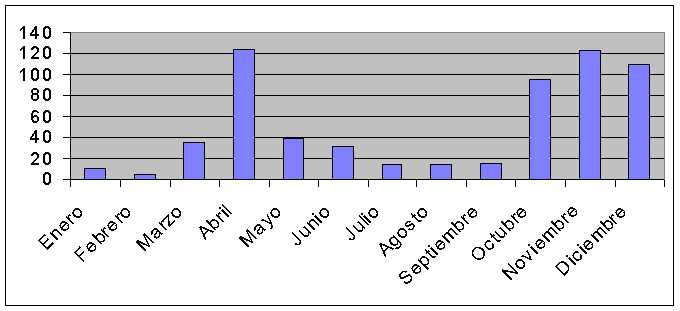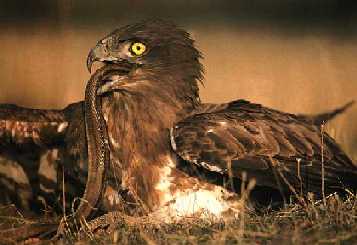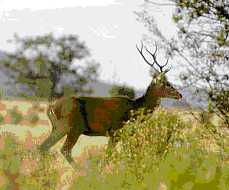












|
|
There are diverse the natural resources that exist in Tubilla of the
Lake. There is not doubt that the water is the most typical natural element,
but it is necessary to know the environment
to discover what the Nature offers us in this zone.
Let's see therefore, the following paragraphs:
|
Tubilla of the Lake, as population placed in the high zone of the
Bank of the Duero, coincides both with his climatology and with vegetation
and fauna with this zone, although a little influenced by the Saw of the Demand,
which is the most next mountainous zone.
It possesses a continental climate, with very cold winters, in which sometimes
12 grades excel themselves under zero, and with scarce precipitations,
which sometimes sporadic are of snow. The summers are warm, going so far as to
reach 35 grades at the end of July and beginning of August, a diet of
precipitations at this station scarce, characterized for the typical
summer thunderstorms. The stations of otoñ and spring are the most
rainy, excelling itself in these periods 80 % of the precipitations of
the whole year.
The winds are more intense in the winter end and the spring
beginning.
In the following table we can appreciate how the
precipitations have been distributed during the year 2000 in liters per square meter throughout
12 months:

The year 2000 611 liters per square meter were gathered in Tubilla,
number that it is possible to consider to be normal, although it is a little over
the average.
Tubilla of the Lake is in a vale that forms the river Gromejón.
This river that is born within a period of Thorny of Cervera, trasncurre
in direction south-west, happening for Tubilla of the Lake, up to the mouth
in the river Duero, to 50 kilometers of his birth.
The altitude is between 875 and 900 meters, something over the average of the
region of The Bank of the Duero.
The soils are characterized by his high place contained in limestone in different zones,
being different, richer in sand. They emphasize also the vales and
vallejos, that they are rich in inorganic matter and very suitable for the culture
of the cereal.
The area is formed by a big ancient miserable baseboard and,
partly, covered by tertiary sediments.
The biggest volume of these sediments is constituted by more or less lenticular layers
of slimy sand or clayish.
He emphasizes the alternation of layers both from limestones and from marls and,
even, from calcareous concretions. Tubilla of the Lake and
The whole Riverside basin formed during the mioceno, presents
horizontal, softly wavy levels limited by the erosion
distinguishing and turned today to the state of plenillanura.
The climatic and geologic conditions, as well as the wealth
florística and the human action on the way they have given place to the
adaptation of different vegetable formations.
Apart from the ,
there exist other species that they bloom in the zone. This way we have between
the trees and the most common shrubs, the pine. We have two
different species, the resin Pine
(Pinus pinaster) and P. Mild (Pinus pinia). The oak that we have is the
Oak gall-oak (Quercus faginea), the Holm oak is (Quercus ilex). In the
black poplar we have several, between the what ones the poplars are since they belong to the
same family, Lombard Black poplar (Populus nigra), white Poplar
(white Populus), tremulous Poplar (tremulous Populus). The junipers, that
it was we who call, they are known as Sabina (Juniperus thurifera), and the junipers (Juniperus communis)
in this zone it calls him esquenos. On the firs, in the zone we do
not have this species if it is not in gardens but not in the field.
Between the plants arbustivas, we have rosemary and thyme especially.
The most interesting species of the avifauna are undoubtedly lads.
In the eagles only
we have the Roadway (Hieraaetus pennatus) and he eagle Culebrera
(Circaetus gallicus), also there are others as the Ratonero
(Buteo buteo), etc.
Other species of abundant birds, they are the pigeons. We meet
the torcaz and the turtledove.
|

|
|
Between the night ones the most common thing the Owl is boy
(it grasped otus), the common owl (white Tyto) and someone more.
|
The mastofauna is represented, between others, by the wild
boar (your scrofa), the fox (Vulpes vulpes), the roebuck and the badger (meles meles).
|

|
In the river Gromejón we can find
two trouts, that of rainbow (Psalm gairdneri) and the common
one (Psalm trutta fario). In ours he laughed there are very abundant also the
Roaches (Roach roach), and very scantly the crab of river.
One of the biggest treasures that offers us the Nature in Tubilla,
is the big quantity of natural springs of drinkable water.
It is an incalculable number of sources that can differ
inside the municipal term, and someone surrounded with a beautiful environment.
Tubilla of the Lake enjoys a privilege of which very few peoples of Spain
can presume. The springs of natural water abound in the surroundings
turning Tubilla into a village rich in this natural resource.
Nevertheless for more than 70 years, Tubilla of the Lake is the people that
supplies the capital of the Bank, Aranda de Duero.
We see next some of the most popular springs of
Tubilla.
Of the springs tubillanos from Fancaliente, in the kilometer 10.5 of
the highway that Gumiel de Hizán joins with Caleruega, to scarce two kilometers of the
center of Tubilla, extracts to himself an approximate wealth of 40 liters per second, canalized
by means of underground tubes, passing for the whole
vega of Tubilla of the Lake up to Aranda de Duero.
It is therefore, Tubilla of the Lake the people that more wealth contributes to the
most important biult-up area of the region, bearing in mind the vital value
of the mineral. From all this contribution, nevertheless, Tubilla of the Lake does
not receive anything in return, since they still keep on fulfilling the laws of that
epoch in which Tubilla did not have option to think about the theft
of the mineral. Bearing in mind that the average consumption for inhabitant establishes in 20 liters
of water newspaper, only this spring would be capable of covering the
needs of a city as Burgos.
The springs of The Eyes, they find in the part North-East of
Tubilla of the Lake to two kilometers of the people. From these springs
there is extracted the water that comes up to the houses of the tubillanos.
This spring, also it is the origin of a channel that was constructed more
than 50 years ago in order to feed a few turbines that in his beginning
were providing electricity to several neighboring peoples, in
addition to turning into irrigation the farms that were adjacent to the channel.
The water of this spring, it is cold, as almost all of this zone,
but account with a high place contained in sales minerals.
Tubilla of the Lake is provided with very diverse zones of playtime, zones of green prairies
with springs of drinkable water; pine groves, more than 3 million square
meters for enjoyment of the one who wants to do it.
|
|
|